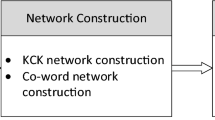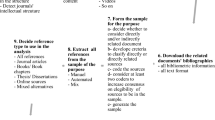Abstract
The understanding of scientific knowledge itself may promote further advances in science and research on the organization of knowledge may be an initiative to this effort. This stream of research, however, has been mainly driven by the analysis of citation networks. This study uses, as an alternative knowledge element, information on the keywords of papers published in business research and examines how they are associated with each other to constitute a body of scientific knowledge. The results show that, unlike most citation networks, keyword networks are not small-word networks but, rather, locally clustered scale-free networks with a hierarchic structure. These structural patterns are robust against the scope of scientific fields involved. In addition, this paper discusses the origins and implications of the identified structural characteristics of keyword networks.



Similar content being viewed by others
References
Abrahamson, E. (1996). Management fashion. Academy of Management Review, 21(1), 254–285.
Baldwin, C. Y., & Clark, K. B. (2000). Design rules: the power of modularity. MA: Cambridge.
Barabasi, A. L., & Albert, R. (1999). Emergence of scaling in random networks. Science, 286(5439), 509–512.
Barnett, G. A., Huh, C., Kim, Y., & Park, H. W. (2011). Citations among communication journals and other disciplines: a network analysis. Scientometrics, 88(2), 449–469.
Crane, D. (1972). Invisible colleges: diffusion of knowledge in scientific communities. Chicago and London: The University of Chicago Press.
Derényi, I., Palla, G., & Vicsek, T. (2005). Clique percolation in random networks. Physical Review Letters, 94(16), 160202.
Ebel, H., Davidsen, J., & Bornholdt, S. (2002). Dynamics of social networks. Complexity, 8(2), 24–27. doi:10.1002/cplx.10066.
Ethiraj, S. K., & Levinthal, D. (2004). Bounded rationality and the search for organizational architecture: An evolutionary perspective on the design of organizations and their evolvability. Administrative Science Quarterly, 49(3), 404–437.
Fleming, L., & Sorenson, O. (2001). Technology as a complex adaptive system: evidence from patent data. Research Policy, 30(7), 1019–1039.
Granovetter, M. (1973). Strength of weak ties. American Journal of Sociology, 78(6), 1360–1380.
Hung, S. W., & Wang, A. P. (2010). Examining the small world phenomenon in the patent citation network: a case study of the radio frequency identification (RFID) network. Scientometrics, 82(1), 121–134.
Kuhn, T. (1962). The structure of scientific revolutions. Chicago: The University of Chicago Press.
Lee, P.-C., Su, H.-N., & Chan, T.-Y. (2010). Assessment of ontology-based knowledge network formation by Vector-Space Model. Scientometrics, 85(3), 689–703.
Li, X., Chen, H., Huang, Z., & Roco, M. C. (2007). Patent citation network in nanotechnology (1976–2004). Journal of Nanoparticle Research, 9, 337–352.
McCloskey, D. N. (1998). The rhetoric of economics. Wisconsin: University of Wisconsin Press.
McGrath, W. E. (1996). The unit of analysis (objects of study) in bibliometrics and scientometrics. Scientometrics, 35(2), 257–264.
Milgram, S. (1967). The small world problem. Psychology Today, 1, 61–67.
Newman, M. E. J. (2005). Power laws, Pareto distributions and Zipf’s law. Contemporary Physics, 46(5), 323–351.
Palla, G., Barabasi, A.-L., & Vicsek, T. (2007). Quantifying social group evolution. Nature, 446(7136), 664–667.
Palla, G., Derenyi, I., Farkas, I., & Vicsek, T. (2005). Uncovering the overlapping community structure of complex networks in nature and society. Nature, 435(7043), 814–818.
Plotkin, H. C. (1997). Darwin machines and the nature of knowledge. MA: Harvard University Press.
Price, D. J. D. (1965). Networks of scientific papers. Science, 149(3683), 510–515.
Ravasz, E., & Barabasi, A. L. (2003). Hierarchical organization in complex networks. Physical Review E, 67(2), 026112.
Ravasz, E., Somera, A. L., Mongru, D. A., Oltvai, Z. N., & Barabasi, A. L. (2002). Hierarchical organization of modularity in metabolic networks. Science, 297(5586), 1551–1555.
Sanchez, R., & Mahoney, J. T. (1996). Modularity, flexibility, and knowledge management in product and organization design. Strategic Management Journal, 17, 63–76.
Simon, H. A. (1962). The architecture of complexity. Proceedings of the American Philosophical Society, 106(6), 467–482.
Solé, R. V., Corominas-Murtra, B., Valverde, S., & Steels, L. (2010). Language networks: their structure, function, and evolution. Complexity, 15(6), 20–26.
Strogatz, S. H. (2001). Exploring complex networks. Nature, 410(6825), 268–276.
Su, H.-N., & Lee, P.-C. (2010). Mapping knowledge structure by keyword co-occurrence: a first look at journal papers in technology foresight. Scientometrics, 85(1), 65–79.
Thompson, J. D. (1967). Organizations in action. New York: McGraw-Hill.
Trajtenberg, M. (1990). A penny for your quotes: patent citations and the value of innovations. RAND Journal of Economics, 21(1), 172–187.
Upham, S., Rosenkopf, L., & Ungar, L. (2010). Positioning knowledge: schools of thought and new knowledge creation. Scientometrics, 83(2), 555–581.
Valverde, S., Sole, R. V., Bedau, M. A., & Packard, N. (2007). Topology and evolution of technology innovation networks. Physical Review E, 76, 56–118.
Watts, D. J. (1999). Small worlds: the dynamics of networks between order and randomness. Princeton: Princeton University Press.
Watts, D. J., & Strogatz, S. H. (1998). Collective dynamics of ‘small-world’ networks. Nature, 393(6684), 440–442.
Weick, K. E. (1976). Educational organizations as loosely coupled systems. Administrative Science Quarterly, 21(1), 1–19.
Wright, S. (1932). The Roles of mutation, inbreeding, crossbreeding and selection in evolution. Proceedings of the VI International Congress of Genetics, 356–366.
Wright, S. (1964). Stochastic processes in evolution. In J. Gurland (Ed.), Stochastic models in medicine and biology (pp. 199–241). USA: University of Wisconsin Press.
Acknowledgments
This work was supported by the National Research Foundation of Korea (NRF) grant funded by the Korea Government (MEST) (No. 2009-0070359).
Author information
Authors and Affiliations
Corresponding author
Appendix: Identifying independent keywords
Appendix: Identifying independent keywords
Stage 1: Identify independent keywords.
-
Uniform rule: For multiple keywords that are considered the same, transform them into a single form, preferably a simple and popular term. For example,
Agent, Agents → Agent.
Case study, Case study research → Case study.
IT, Information technology → IT (other examples are CEO, E-MAIL, R&D, M&A, E-business).
MCMC, Markov chain Monte Carlo, Markov chain Monte carlo (MCMC) → Markov chain Monte Carlo.
CRM, Customer relationship management, Consumer relationship management → Customer relationship management.
Technology management, Management of technology → Technology management.
-
Split rule: If a keyword consists of multiple independent keywords, split them. For example,
Efficiency and effectiveness → Efficiency, Effectiveness.
Discrete/Continuous Choice Model → Discrete choice model, Continuous choice model.
Stage 2: Double-check important keywords.
-
Identify important keywords that appear in many papers or have a high degree of betweenness centrality in the keyword network. Stage 1 errors for these keywords can have a relatively large impact on analysis results.
-
Rerun important keywords through the first stage to minimize errors with these words.
Rights and permissions
About this article
Cite this article
Yi, S., Choi, J. The organization of scientific knowledge: the structural characteristics of keyword networks. Scientometrics 90, 1015–1026 (2012). https://doi.org/10.1007/s11192-011-0560-1
Received:
Published:
Issue Date:
DOI: https://doi.org/10.1007/s11192-011-0560-1




